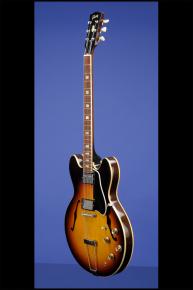The Last of the "Great" 335s.
This 16-inch-wide semi-hollow body guitar, with a solid maple block running lengthwise down the center, weighs 8.20 lbs. and has a laminated maple body with single binding on the top and bottom edges. One-piece mahogany neck with a wonderful medium-to-thick '64 profile, a nut width of just under 1 11/16 inches and a standard Gibson scale length of 24 3/4 inches. Brazilian rosewood fretboard with 22 jumbo frets and inlaid pearl block position markers. Headstock with inlaid pearl "Gibson" logo and pearl crown inlay. Individual two-line Kluson Deluxe tuners with double-ring Keystone plastic buttons and "D-169400 PATENT NO." stamped on the inside. Serial number ("340864") stamped on the back of the headstock. Five-layer (black/white/black/white/black) plastic pickguard with beveled edge. Two super hot "patent number" humbucking pickups with outputs of 7.65k and 7.88k. Four controls (two volume, two tone) plus three-way selector switch and jack socket, all on lower treble bout. Gold plastic bell-shaped knobs with white markings and metal tops. ABR-1 Tune-O-Matic retainer bridge with nylon saddles and nickel trapeze tailpiece with diamond on cross-bar. With the Gibson 'Kalamazoo' orange oval label inside the bass 'f' hole with style ("ES-335TD") and the serial number ("340864") stamped in black. There is some inevitable and very light finish checking on the top and two tiny surface marks, one on the lower edge of the top (by the trapeze tailpiece) and the other on the side just by the bridge pickup tone control. Still this super guitar is in absolutely mint (9.50) condition. It has hardly ever been played as is evidenced by the minute amount of wear on the first three frets only. This is an opportunity to buy a basically "brand-new' forty-three year old guitar with that oh so perfect neck profile… Housed in its original Gibson "Lifton" black hardshell case with orange plush lining (9.50)
This a "transitional" example, and being an early 1965, is one of the first to be fitted with the new style "trapeze" tailpiece, while still retaining the preferred "fat" nut width of 1 11/16 inches. In early to mid 1965 the nut width was decreased to 1 9/16 inches (known as the small neck), and then in 1966 the specifications were radically changed: the peghead angle was changed from 17 degrees to 14 degrees and Indian Rosewood replaced the Brazilian Rosewood on the fretboard. Although a total of 712 ES-335TDs were produced in 1965, the number of "earlier" examples such as this one with the 1964-style neck, is infinitely smaller. This is truly the last of the great 335's which dominated the thinline electric guitar market from the spring of 1958 to the beginning of 1965.
"Introduced in 1958, the ES-335T (originally no final D) truly ranks among the all-time Gibson classics, not only because of its enduring popularity but also because of its semi-solid construction which pioneered a new style of electrics" (A.R. Duchossoir, Gibson Electrics -- The Classic Years, p. 231).
"There were indeed a number of firsts in the early days of the electric guitar, but in retrospect only few of them can be considered as true milestones. The double cutaway thinline pioneered by Gibson in 1958 genuinely rank amongst the great original designs. Their graceful shape was truly innovative at the time and spawned several imitations such as Gretsch's revamped Chet Atkins series or the Guild Starfire. But perhaps the most important hallmark of the new thinline was their semi-solid construction. Indeed Gibson's prime objective was to design an instrument that would combine the advantages of both solid and hollow body electrics and therefore appeal to a variety of players, regardless of their musical style" (A.R. Duchossoir, Gibson Electrics -- The Classic Years, p. 77).
Translate:










